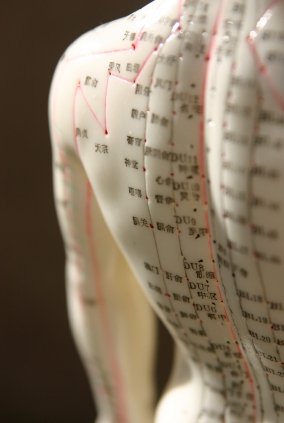
REGISTERED ACUPUNCTURE & CUPPING THERAPY
Explore the benefits of acupuncture and how it can help you address acute and chronic pain, alleviate daily stress, and treat a wide range of health complaints to improve your overall quality of life.
Registered Acupuncture and Cupping Therapy in Richmond
What is Acupuncture?
Acupuncture is a therapeutic modality that involves the insertion of single-use, sterile needles to stimulate specific points on the body known as acupuncture points. These acupuncture points are primarily located along different pathways of the body, known as meridians, for the flow of Qi (energy). During acupuncture, the needles are carefully inserted into the body and manipulated to activate Qi. This results in restoring the balance of Qi in the body. As the balance of Qi is restored, it promotes the body's natural healing processes.
What Does a Traditional Chinese Medicine (TCM) Practitioner and Acupuncturist Do?
TCM Practitioners and Acupuncturists look at the balance of body and mind to determine how to restore the balance of Qi and optimize health. They have extended clinical practice, advanced training, and substantive theoretical knowledge. TCM practitioners and acupuncturists are trained to diagnose various conditions and can help prevent disease and manage certain disorders and imbalances using a range of treatments.
Treatment and Benefits of Acupuncture and TCM
Alleviate pain and discomfort in various parts of the body, including back, neck, and joint pains
Chronic pain management
Headaches/migraines
Immune system support: strengthen the immune system by increasing white blood cell count, stimulating the production of antibodies, and improving lymphatic circulation
Digestive health: irritable bowel syndrome (IBS), gastritis, hemorrhoids
Mental health support
Anxiety and stress management
Improve quality of sleep
Post-Traumatic Stress Disorders (PTSD) management
Insomnia
Fertility support: menstrual pain, infertility
Management of Chronic Conditions: arthritis, asthma, and hypertension, etc
Smoking cessation
Treatment Modalities
Acupuncture Therapy: Traditional Chinese Medicine Practitioners believe there are over 2,000 acupuncture points throughout the body. These specific points run along energy pathways, also known as meridians, or Jing Luo. There are a variety of concepts that are fundamental to Traditional Chinese Medicine theory, but fundamental to each theory is the idea of balance and harmony. Disease occurs in the body when your body is no longer in balance. Acupuncture needles are inserted in the body to promote or reduce energy in an attempt to bring the body into it’s natural equilibrium.
Cupping Therapy: Cupping therapy involves placing cups on the skin's surface, creating a vacuum to suction and lift the skin. This technique is traditionally performed with various materials such as glass, bamboo, or silicone cups, aiming to promote myofascial release, improve blood circulation, and alleviate local congestion. Cupping is believed to have therapeutic benefits in traditional medicine, addressing issues like pain relief, blood stasis, and promoting the smooth flow of energy (Qi) in the body's meridians.
Laser Acupuncture Therapy: Laser acupuncture is a form of non-invasive acupuncture that irradiates acupoints or myofascial tenderness areas with use of low-energy lasers, making it an ideal alternative for patients who are sensitive to or have a fear of needles, including children. This treatment is painless, non-invasive, and promotes soft tissue regeneration. To read more about laser acupuncture, visit here.
Auriculotherapy: Auricular acupuncture is the practice of healing pathological problems using the external surface of the ear. This can include inserting fine needles or placing ear seeds on the ear surface to stimulate it’s corresponding somatotopic region of the body! Auricular acupuncture can be done on it’s own as a form of treatment, or combined with body points.
Acupressure/Tui Na: A form of Chinese manipulative therapy that focuses on adjusting and realigning the body's musculoskeletal system using various massage and manipulation techniques. It aims to promote the flow of qi, alleviate pain, and restore balance within the body's energy pathways.
Gua Sha: Gua Sha, or scraping, involves scraping the skin's surface with a tool to stimulate blood flow and promote healing. This traditional Chinese medicine technique is helps to remove stasis, detoxify, increase immune function, and aids in soft tissue injuries.
Acupuncture Frequently Asked Questions
-
Acupuncture therapy is a form of traditional Chinese medicine that involves inserting thin needles into specific points on the body known as acupuncture points. The goal is to stimulate these points to promote the flow of energy, known as Qi, and restore balance within the body.
Acupuncture is commonly used to alleviate pain, reduce stress, promote relaxation, and address various health conditions.
-
The sensation experienced during acupuncture can vary widely among individuals. Some people report feeling a slight tingling or a dull ache when the needles are inserted, while others may not feel much at all.
Sensations such as warmth, heaviness, or a sense of relaxation can also occur during the treatment.
In general, acupuncture is not typically described as painful, and many people find it to be a relaxing and therapeutic experience.
-
Acupuncture is considered to be safe when performed by a qualified and experienced practitioner using sterile needles. Serious side effects are rare, but minor ones such as soreness, bruising, or bleeding at the insertion site can occur. Acupuncturists at Sano Wellness are licensed and follows a strict hygiene practice to minimize any risks.
-
Acupuncture treatment is generally not painful, but some people may experience a slight discomfort or a brief, sharp sensation. Overall, acupuncture is considered a safe and relatively painless treatment.
-
After an acupuncture session, it's essential to follow your practitioner’s post-treatment recommendations to maximize the benefits of the treatment and minimize any potential side effects.
Some common post-treatment care may include:
Hydrate: Drink plenty of water to stay hydrated.
Rest: Allow yourself time to rest and relax after the session. Avoid strenuous activities or heavy exercise immediately afterward.
Avoid stimulants: Limit consumption of caffeine and alcohol for the remainder of the day to support your body's natural healing process.
Eat a light meal: Have a nourishing, light meal to replenish your energy levels. Avoid heavy or greasy foods that may weigh you down.
Gentle movement: Engage in gentle activities such as walking or stretching to promote circulation and maintain flexibility.
Schedule follow-up appointments: Depending on your treatment plan and goals, consider scheduling regular acupuncture sessions to maintain the benefits and address any ongoing health concerns.
-
The frequency of acupuncture treatments will depend on the individual’s condition and goals. Acute conditions may require more frequent treatments, while chronic conditions may require ongoing maintenance sessions. Ferl free to discuss and establish an individualized treatment plan with your acupuncturist.
-
Acupuncture offers a wide range of health benefits, although individual experiences may vary. Please see page above for some of the many benefits you may encounter.
-
No, you don't necessarily need to have a specific concern to benefit from acupuncture. While acupuncture is often sought out to address specific health issues or symptoms, many people also use it as a preventive measure to maintain overall well-being and promote relaxation.

Registered Acupuncture is covered through most extended health benefit plans and ICBC. Direct billing is available at Sano Wellness to most health insurers.


